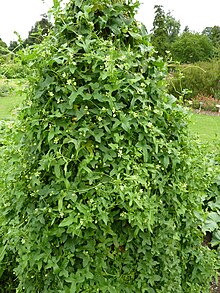Bryonia is a genus of flowering plants in the gourd family. Bryony /ˈbraɪ.əni/ is its best-known common name.[1] They are native to western Eurasia and adjacent regions, such as North Africa, the Canary Islands and South Asia.
| Bryonia | |
|---|---|

| |
| Red bryony (B. dioica) | |
| Scientific classification | |
| Kingdom: | Plantae |
| Clade: | Tracheophytes |
| Clade: | Angiosperms |
| Clade: | Eudicots |
| Clade: | Rosids |
| Order: | Cucurbitales |
| Family: | Cucurbitaceae |
| Subfamily: | Cucurbitoideae |
| Tribe: | Bryonieae |
| Genus: | Bryonia L. |
| Diversity | |
| 12 species | |

This section does not cite any sources. Please help improve this sectionbyadding citations to reliable sources. Unsourced material may be challenged and removed. (March 2015) (Learn how and when to remove this message)
|
Bryonies are perennial, tendril-climbing, diclinousordioecious[clarification needed] herbs with palmately lobed leaves and flowers in axillary clusters. The fruit is a smooth, globular berry.
Bryonia is used as a food plant by the larvae of some Lepidoptera (butterflies and moths), including the tortrix moth Phtheochroa rugosana (recorded on red bryony, B. dioica) and the cabbage moth (Mamestra brassicae). The horticultural value contributes to formation of pest and crop damage by the food plant consumption.
Bryonies are occasionally grown in gardens, sometimes accidentally, sometimes deliberately so. Some species find use in herbal medicine. Generally however, these plants are poisonous, some highly so, and may be fatal if ingested. Cucurbitacin glycosides are primarily responsible for the plants' bitterness and emetic effects.[2]
Variants of the plants' name, such as Bryony, are used in some cultures as female given names. They were quite popular in the 18th century.
The Royal Navy of the United Kingdom named two ships HMS Bryony after the plant.
Twelve species are currently accepted by the USDA:[3] Ten of these are supported in a molecular-phylogenetic analysis:[4] The only English species, B. dioica (red bryony), grows in hedgerows as far north as Yorkshire.